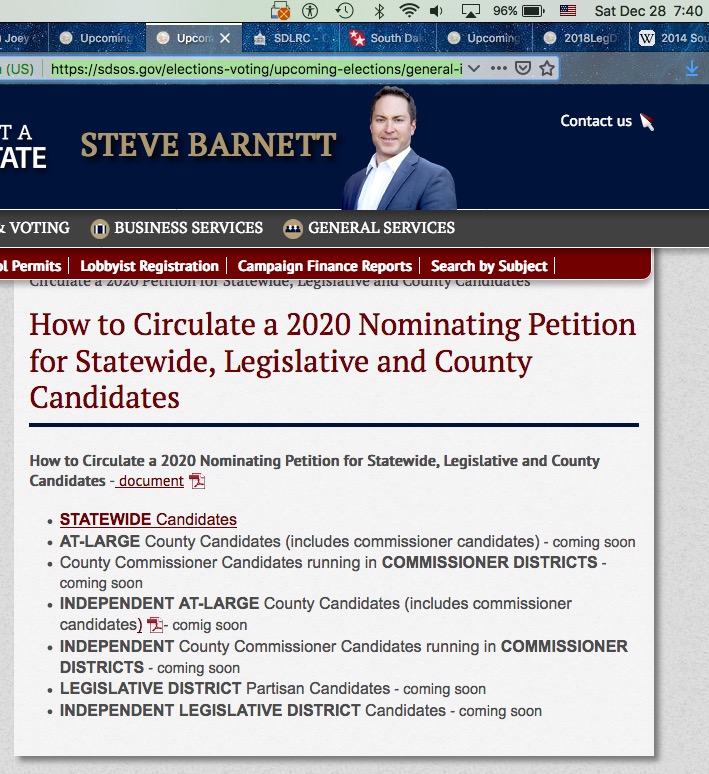My joy at the prospect of shoveling four times this weekend to keep up with the blizzard (this is how we burn up Christmas cookies!) is dampened by the apparent laziness in the Secretary of State’s office. Candidates can start circulating petitions for office just four days from today, and Secretary of State Steve Barnett still hasn’t posted the signature requirements for most offices!

The Secretary has posted petition signature requirements for just two categories of candidates: statewide and independent at-large county. Legislative candidates, partisan at-large county candidates, and county candidates running in commissioner districts have no guidance yet.
The statewide candidate signature counts are easy to calculate::
- Candidates of established parties need to collect signatures from fellow party members totaling not less than 1% of the vote that their party’s candidate for Governor got in the last election (SDCL 12-6-7). Based on the official 2018 canvass, Republicans thus need 1,730 to run for U.S. Senate or U.S. House, while Democrats need 1,615. Those petitions are due March 31.
- Independent candidates have to submit signatures (from any registered voter, not just indies!) totaling not less than 1% of the last total gubernatorial vote (SDCL 12-7-1). This time, that means 3,393 to run indy for Congress or PUC. Indy petitions are due April 28.
- Libertarians, as an “alternative” party, as well as candidates of any new party angling for a primary battle can submit 250 signatures from fellow party members (SDCL 12-5-1.4, referenced by SDCL 12-5-25… and unless I’m missing something, Secretary Barnett has erred in posting that Libertarians need only 50 signatures to run statewide). While circulating petitions can be a great party-building activity for candidates, new and alternative parties can skip petitions and the March 31 deadline altogether and nominate all of their candidates at convention in the summer! (Certification of nominations are due in the Secretary of State’s office by August 11, per SDCL 12-5-25).
Signatures for at-large county candidates follow the same basic formula: 1% of your last gubernatorial candidate’s tally in your county for Republicans and Democrats, 1% of your county’s last total gubernatorial vote for independents, and five signatures (SDCL 12-5-1.4) for new/alternative party candidates. (Interesting: alternative parties get no convention option for county candidates.) The wrinkle is that if an at-large county uses voting centers, where ballots aren’t marked by precinct and voters can cast their ballots at any polling site in the county, the signature count is 30 signatures for main party and independent candidates (SDCL 12-6-7). Brookings, Brown, Hughes, Hyde, Potter, Sully, and Yankton, so their county candidates all need to go get 30 signatures.
SOS Barnett gives a link for independent at-large county candidates showing the gubernatorial vote totals for 2018. But partisan candidates can use that same sheet to figure their at-large county signature requirements: for instance, in Custer County, Democrats will need to get 16 signatures, while Republicans will need to get 28. In Minnehaha, Democrats will need 372 while Republicans will need 322.
Figuring the signature requirements for county district seats and Legislative seats requires more granular data about the 2018 gubernatorial vote within those districts. The SOS website doesn’t post that data, so I can’t tell you the 2020 numbers. But I can tell you this much about Legislative petition signature requirements:
- If your district includes any part of any county that uses voting centers, your signature requirement is 50 (SDCL 12-6-7; by 2018’s rules, that’s Districts 1, 2, 3, 4, 7, 18, 23, and 24).
- If your district consists of one or more entire counties, none of which use voting centers (Districts 8, 17, 20, 22, 26, and 31), add up your party’s gubernatorial vote in each of your district’s counties and multiply by 1%. Round up to the nearst whole number; your signature requirement is that result or 50, whichever is less.
- For instance, District 31 is all of Lawrence County. Noem beat Sutton in Lawrence County 5,984 to 4,675. Republicans running in District 31 thus need 50 signatures; Democrats need 47.
- District 8 consists of Moody, Lake, Miner, and Sanborn counties. Across those four counties, Sutton beat Noem 5,127 to 4,939, so both Legislatively inclined Democrats and Republicans running along the eastern quarter of Highway 34 need 50 signatures.
- If you’re in a non-voting center district that divides or gerrymanders one more counties (Districts 5, 6, 9–16, 19, 21, 25, 27–30, 32–35) you’ll need precinct-level results.
As I said, I don’t have all of the necessary election data handy… but I’m also not Secretary of State getting paid $93,045.87 a year to use my unlimited access to the master election database to figure stuff like this out and do it well before petition season opens! Hurry up, Steve! Democracy hangs in the balance!
Related Stats: In 2020, there may be a few more Legislative districts where Republicans get to bring in fewer than 50 signatures, since Noem 2018 got about 12% fewer votes than Daugaard 2014. More Democrats will need to get the full 50, and almost all will see higher thresholds, since Sutton 2018 got 2.28 times as many votes as Wismer 2014.
Those differences affect the statewide candidates more significantly: Republicans running for Congress this year and for Governor in 2022 will need 225 fewer signatures to make the ballot than they did in 2016 and 2018, while statewide Democratic candidates this election and next will need 909 more signatures than the last two times around. Since overall voter turnout in 2018 was 22% higher than in 2014, independents will need 618 more signatures to get on the statewide ballot in 2020 and 2022 than did Michael Myers back in 2014.
Young Mr. Barnett is probably getting advice and the steps to do from Mr. Gant, he of the full 4 year experience plus much time in the legislatures.